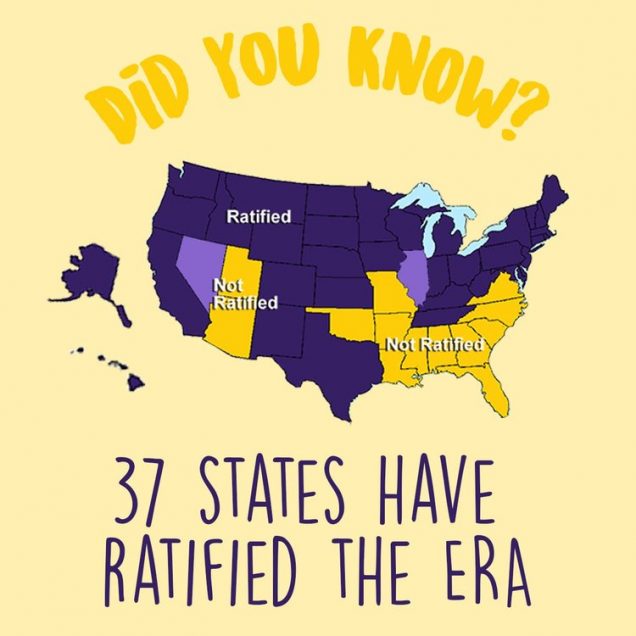Examining the ERA’s Comeback: the Legal Debate Over a 38th Ratification
At a time when the issues of gender and sexual harassment have come to a head, some activists are looking to a decades-old proposed constitutional amendment to secure gender equality. The Equal Rights Amendment (“ERA”), originally proposed by suffragist Alice Paul in 1923, would affirmatively state that no person’s rights under the law may be denied or abridged based on sex. This would raise the level of judicial scrutiny afforded to claims of gender discrimination from the “intermediate” and often uncertain level of scrutiny to the much more arduous level of strict scrutiny. Strict scrutiny would make gender a protected class and grant legal safeguards for gender discrimination claims on par with those of claims of racial discrimination. Despite renewed public support for the ERA, its complicated history and potential future passage raise contentious legal issues.
The ERA was introduced in every Congressional session from 1923 until its eventual passage in 1972. After passage, the landmark legislation went to the states for ratification; needing the ratification of at least 38 states—two thirds of the states—before the congressionally imposed deadline of March 22, 1979. While there was an initial surge in ratification, only 35 states ultimately ratified the ERA. Congress extended the deadline to June 30, 1982, however no other states ratified in that time.
After the deadline passed without the prerequisite ratification, the ERA largely disappeared from the national conversation and lay dormant until its contemporary resurgence. Millions participated in the Women’s Marches in response to President Trump’s election, and the #MeToo movement aimed at ending workplace sexual assault and harassment; both reflect a renewed push for gender equality. In light of those movements, the ERA, too, gained steam. On March 22, 2017, exactly 45 years after Congress first passed the ERA, Nevada became the 36th state to ratify the amendment. A little over a year later, on March 30, 2018, Illinois followed suit, leaving the ERA needing only one more state to reach the required two-thirds of states. The final necessary ratification may come in the upcoming legislative session beginning in January, as Virginia lawmakers have recently wrapped up VAratifyERA, a 10-day, bipartisan bus tour of Virginia aiming to gather support for the bill across the state.
 While activists pursue a 38th ratification, legal scholars debate the legitimacy of a passage of the amendment so far beyond Congress’ deadline. Does Congress have the power to simply extend the deadline again and certify the ERA’s passage if a 38th state passes it, or did the ERA expire in 1982, rendering a 38th ratification moot?
While activists pursue a 38th ratification, legal scholars debate the legitimacy of a passage of the amendment so far beyond Congress’ deadline. Does Congress have the power to simply extend the deadline again and certify the ERA’s passage if a 38th state passes it, or did the ERA expire in 1982, rendering a 38th ratification moot?
According to a 2018 Congressional Research Service (CRS) report on the ERA and ratification issues, ERA advocates argue that a contemporary ratification is valid given Congress’ broad authority over the constitutional amendment process, including the power to extend or limit the deadline for the ERA. ERA supporters point to Article V of the Constitution—giving Congress broad power to propose amendments “whenever two thirds of both houses shall deem it necessary” and stating that proposed amendments are “valid to all intents and purposes” when ratified by the legislatures of three fourths of states—to argue that Congress may extend ratification deadlines as it sees fit. Notably, Article V does include any specific time limits related to constitutional amendments, while other constitutional rules with time periods are explicitly specified. Proponents of the ERA, including Nevada’s ERA Ratification Organizer, point to the 27th Amendment’s ratification process to support an expanded—if not long—ratification process. The 27th Amendment, the most recent amendment to the Constitution imposing rules on increases or decreases to the salaries of members of Congress, was introduced in 1789, without a deadline, and was not fully ratified until 1992. ERA supporters argue that Congress can extend deadlines where the time limits appear only in the original proposing clause, not the text of the amendment itself. Finally, the fact that Congress already extended the deadline once suggests that Congress has the power to do so again.
According to the CRS report, opponents argue that despite Congress’ plenary power over the constitutional amendment process, extending the ERA deadline to allow for contemporary ratification would be unconstitutional because of ratifying states’ potential reliance on the time period in their decision to ratify. However, since the deadline was only in the proposing clause and all of the states’ ERA ratifications prior to the first deadline extension raised no constitutional issues, this argument may lack merit.
Significantly, a 38th ratification of the ERA may raise the question of whether states’ rescinding of ratifications of constitutional amendments are valid, as five states—Idaho, Kentucky, Nebraska, South Dakota, and Tennessee—have withdrawn their ratifications. This is not a settled area of law, but ERA proponents argue that such rescissions are not legal, as Article V provides only for ratification procedures, not rescission. The passage of the Fourteenth Amendment in 1868 lends credence to this argument, at it was certified based on the ratification of a two-thirds majority of states including Ohio and New Jersey, despite the fact that they had previously attempted to withdraw ratification. Additionally, the Supreme Court has been reluctant to weigh in on the validity of states’ ratifications of recessions of constitutional amendments. In Coleman v. Miller (1939), the Court regarded the question of the “efficacy of ratifications by state legislatures…” as a political question and did not issue a ruling on the merits. Therefore, it is likely that Congress could certify the ERA in a similar vein to the Fourteenth Amendment—that is, including ratifications from states that have since attempted to withdrawal their ratifications—legally and without intervention from the courts.
While the legal status of a 38th state ratification may be murky, the importance of the ERA today is clear. United States Supreme Court Justice Ruth Bader Ginsburg has supported the ERA, arguing that while recent women’s rights advancements through legislation are positive, it could be repealed without an underlying principle of equality enshrined in the Constitution. For example, a 2012 Wisconsin Act rolled back protections for victims of wage discrimination. Practically, the ERA’s heightened scrutiny on gender discrimination cases would go a long way in preventing rollbacks of laws protecting gender equality as well as preventing the implementation of laws that actively discriminate based on gender. For example, the ERA would likely have prevented the rollback of the Wisconsin wage equality law. Experts also argue that a heightened level of scrutiny for gender discrimination claims likely would have changed the outcome of the famous 2014 Burwell v. Hobby Lobby case, which allowed for-profit companies to deny its employees health coverage of contraception based on religious objections. If the ERA can win its final state ratification and pass through the many legal hurdles it faces, it would represent the realization of an almost century-long ordeal to ensure a basic principle of equal protection and rights under the law regardless of gender.
 Chloe Aubuchon graduated from the University of Michigan with a B.A. in International Studies and Spanish in 2017 and anticipates graduating from Boston University School of Law in May 2020.
Chloe Aubuchon graduated from the University of Michigan with a B.A. in International Studies and Spanish in 2017 and anticipates graduating from Boston University School of Law in May 2020.

